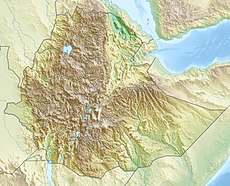Battle of Das
| Battle of Das | |||||||
|---|---|---|---|---|---|---|---|
| |||||||
| Belligerents | |||||||
| Ethiopian Empire |
Adal Mora Harla Zeila Dawaro | ||||||
| Commanders and leaders | |||||||
|
Amda Seyon | Salih † | ||||||
| Strength | |||||||
| 2,722 men[1] | 12,048 men (Ethiopian sources) | ||||||
| Casualties and losses | |||||||
| Unknown | ~10,000+ killed | ||||||
Location of Das according to G.W.B Huntingford | |||||||
The Battle of Das was fought in 1332 between the
Background
According to the chronicler, the
Battle
In July 1332, Salih and his army set out to
Early in the battle, upon seeing the size of the Muslim army, some Ethiopians had begun to flee. Amda Seyon then gathered a handful of horsemen and attacked the left flank of the Muslim army. According to the chronicler, Amda Seyon then took his spear and began slaying the Muslims, even killing two men with one blow. The Muslim army were forced into a ditch where upon the king dismounted from his horse, took his shield and began to strike them. The king then mounted back on his horse and pursued the fleeing enemies with his men, forbidding them from taking any loot. When the enemy's left wing was fully destroyed, Amda Seyon and his men went around to the rear of the Muslim right wing, immediately dispersing them.[9]
According to the chronicler, over 10,000 Muslims were killed in this battle, including their leader Salih.[10]
Aftermath
Following this victory, the Emperor went on to Ta’rak which he had massacred all who opposed him and returned to his camp. He then raided the town of Zasaye, and then destroyed it and slew the governor ‘Abd Allah; the town of Abalgi was next raided and all who resisted were massacred. 'Amda Seyon then marched into the district of Talag, where the king of Adal lived, the king of Adal was captured, and he and all his people were massacred. Then the three sons and the brother of the king of Adal came, and laying their sandals on their heads, they tendered their submission, did homage to 'Amda Seyon and begged for mercy.[11]
References
- ^ Huntingford, G.W.B (1965). The Glorious Victories of 'Āmda S̥eyon, King of Ethiopia. Clarendon Press. p. 82.
- ^ Huntingford, G.W.B (1965). The Glorious Victories of 'Āmda S̥eyon, King of Ethiopia. Clarendon Press. p. 82.
- ^ Chekroun, Amelie. Le" Futuh al-Habasa" : écriture de l'histoire, guerre et société dans le Bar Sa'ad ad-din. l’Université Paris 1 Panthéon-Sorbonne. p. 149.
- ^ Jamal Ad-din Mansur. Encyclopedia Aethiopica.
- ^ Huntingford, G.W.B (1965). The Glorious Victories of 'Āmda S̥eyon, King of Ethiopia. Clarendon Press. p. 82.
- ^ Huntingford, G.W.B (1965). The Glorious Victories of 'Āmda S̥eyon, King of Ethiopia. Clarendon Press. p. 82.
- JSTOR 42731359.
- ^ Hrbek, Ivan. Africa from the Seventh to the Eleventh Century. Heinemann Educational Books. p. 584.
- ^ Huntingford, G.W.B (1965). The Glorious Victories of 'Āmda S̥eyon, King of Ethiopia. Clarendon Press. p. 90.
- ^ Huntingford, G.W.B (1965). The Glorious Victories of 'Āmda S̥eyon, King of Ethiopia. Clarendon Press. p. 90.
- ^ A. Wallace Budge, E. (1828). History Of Ethiopia Nubia And Abyssinia. Vol. 1. Methuen & co. p. 296.

